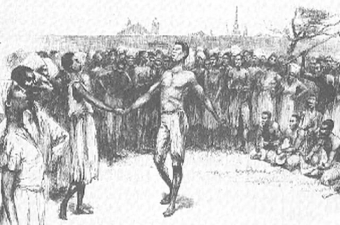Congo Square
Armstrong ParkNew Orleans LA 70116
To visit this site, enter Louis Armstrong Park at 801 N Rampart Street and once inside turn left, in front of the Municipal Auditorium.
Congo Square is one of the most hallowed sites in American music history. This area, once a grassy commons behind the original city rampart (now Rampart Street), was one of several gathering places for enslaved people from Africa and their descendants. In the 1700s, under French and Spanish colonial rule, slaves were permitted to buy and sell goods on Sundays. They also played African-style musical instruments and performed dances that originated from their native homes. After New Orleans became part of the United States in the early 1800s, a city ordinance limited gatherings of slaves to this spot, and only until sunset. Still, the weekly ritual sustained a continuum of African culture in the New World, with profound implications for the future of music.
The African and Caribbean cultural expressions that thrived there sowed the seeds of New Orleans’ jazz, second-line, and Mardi Gras Indian traditions. Participants came from different African nations, and played a variety of styles of music. The spectacle of hundreds of people drumming and dancing the Bamboula and the Calinda attracted all kinds of visitors, from domestic workers and free people of color to curious outsiders likely including composer Louis Moreau Gottschalk, whose work would be influenced by what he heard.
Music and dance in Congo Square served vital functions: They were a spiritual practice, a force for social cohesion, and a form of resistance to the city’s degrading racial order. Local leadership understood as much and subjected them to increasing regulation and oversight in the mid 1800s. In 1893 the grounds were landscaped and renamed for the Confederate general P.G.T. Beauregard (most of the oak trees on the grounds today date from this time). Soon afterward the city established a playground on the site, restricted to white people only.
Decades passed before a critical mass of non-Black New Orleanians and elected officials recognized the significance of the land. In the meantime the cultural legacy of Congo Square grew wider: the rhythmic sensibilities sustained here had influenced not only the development of jazz, but of American popular music generally. It is no coincidence that the drummer credited with pioneering the rock and roll back beat, Earl Palmer, grew up near Congo Square, following the drummers in street parades. Mardi Gras Indians and social aid and pleasure clubs still mask and parade through the area today, moving to African-derived rhythms and perpetuating the legacy of music and dance as communally uplifting expressions.
For more about Louis Armstrong Park, click here.
For more about the Treme neighborhood, click here.
Videos

Author Freddi Evans offers an introduction to Congo Square.
Video courtesy of Kevin McCaffrey.
Author Freddi Evans offers an introduction to Congo Square.
Images





















